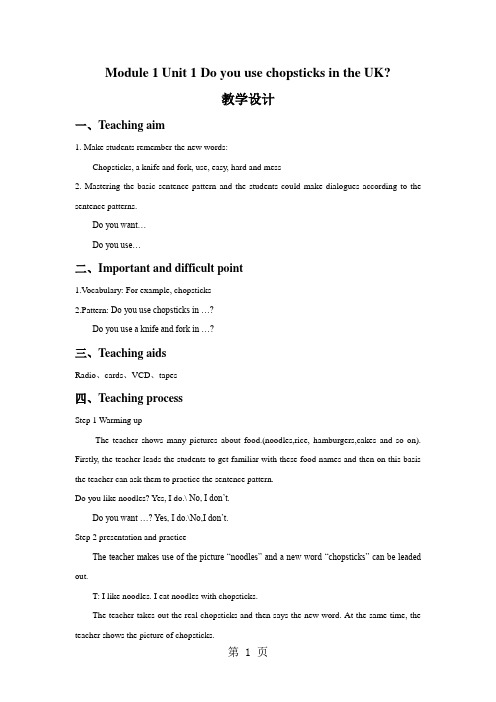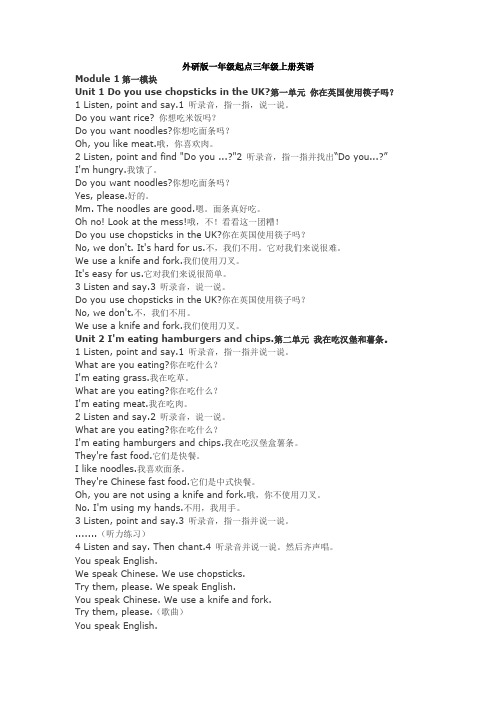三年级英语上册Module1Unit1DoyouusechopsticksinEngl
- 格式:ppt
- 大小:2.91 MB
- 文档页数:13

三年级上册英语说课稿-Module1 Unit 1 Do you use chopsticksin the UK?一、教学目标知识与能力1.了解有关国家使用的餐具及文化差异;2.学习使用简单的英语问答和表达自己的偏好;3.通过听说读写四个方面,提高英语交流能力。
情感态度价值观1.培养学生的跨文化意识,尊重不同的文化;2.培养学生的英语学习兴趣和语感;3.培养学生的团队合作精神和表达能力。
二、教学重点和难点1.学会美食名词和制定问题的英文表达;2.发展听说读写四项能力。
三、教学过程Step1:导入新课1.与学生共同观看图片:在中国,我们使用筷子,但在其他国家呢?2.引导学生思考“Do you use chopsticks in the UK?”的意义,让学生思考出答案,并解释文化差异的重要性。
Step2:学习新词汇1.学生边观看图画,边听老师的词汇朗读。
同桌讨论并记下生词。
Step3:角色扮演1.教师和学生进行互动交流,模拟用英语提问和回答筷子在其他国家是否使用以及对筷子的偏好(包含喜欢和不喜欢)。
2.引导学生在团队中玩游戏,让孩子们分角色,尝试用英语问答,并以3-5个句子描述自己喜欢或不喜欢使用筷子,并讨论造成这种偏好的原因。
让学生自由展示。
Step4:朗读练习1.按照语音、语调的标准,轮流朗读课文内容,让学生模仿,调节语音语调。
Step5:语言拓展1.引导学生制定问题和回答,例如“What do you eat with in ….?”,“Do you like eating with …?” 的答案。
Step6:学以致用1.让学生在这个话题上进行写作练习,让学生运用所学知识描述自己的用餐习惯。
四、师生互动及评价1.师生互动:教师引导学生思考问题,并让学生自由展示;2.评价:教师通过学生的课堂表现、作业和最终考试结果来评价教学效果。

Module 1 Unit 1 Do you use chopsticks in the UK?教学设计一、Teaching aim1. Make students remember the new words:Chopsticks, a knife and fork, use, easy, hard and mess2. Mastering the basic sentence pattern and the students could make dialogues according to the sentence patterns.Do you want…Do you use…二、Important and difficult point1.V ocabulary: For example, chopsticks2.Pattern: Do you use chopsticks in …?Do you use a knife and fork in …?三、Teaching aidsRadio、cards、VCD、tapes四、Teaching processStep 1 Warming upThe teacher shows many pictures about food.(noodles,rice, hamburgers,cakes and so on). Firstly, the teacher leads the students to get familiar with these food names and then on this basis the teacher can ask them to practice the sentence pattern.Do you like noodles? Yes, I do.\ No, I don’t.Do you want …? Yes, I do.\No,I don’t.Step 2 presentation and practiceThe teacher makes use of the picture “noodles” and a new word “chopsticks” can be leaded out.T: I like noodles. I eat noodles with chopsticks.The teacher takes out the real chopsticks and then says the new word. At the same time, the teacher shows the picture of chopsticks.An activity can be made here. The title of the activity is saying words as quickly. The pronunciation of new word is a difficult point. So the teacher should ask students to practice more. Step 3The new word “use” can be leaded out in the process of communication.T: Can you use chopsticks?The word card of use should be shown.We use chopsticks in China. And the teacher writes the sentence on the blackboard.We use chopsticks.Do you use chopsticks? Yes, we do. No, we don’t.Ask and answer in pairs.The teacher inquires the students if the English people useChopsticks and a knife and fork will be leaded out.T: We use chopsticks in China. Do the English people use chopsticks?S: No, they don’t.English people use a knife and fork.Do you use chopsticks / a knife and fork? Yes, I do. No, I don’t.Step 4(1)Presentation of the text.Amy and Daming are in the park. They want to eat noodles. Watch the CD-ROM, then answer the questions: “Does Amy use chopsticks in England?”The students look at the CO-ROM and then answer questions.Now Amy is using chopsticks. Watch again, then answer the next question: Are the chopsticks “easy” or “hard” for her?easy – hardChopsticks are hard for Amy.A knife and fork are easy for her.Some other oposite words are shown here.big-smalllong-shortfat-thinhot-coldwhite-blackeasy-hardListen again, then answer:Are the chopsticks “easy” or “hard” for English people?T: If I say “big”. You should say “small”. Please say the words as quickly as you can.Chopsticks are hard for English people. So Amy make the mess.Then the students read the passage again.Find the sentences, “ Do you …?”. Then circ le them.五、Homework1. Read the dialogue and the sentence.2. Preview Module 1 Unit 2.。


三年级英语上册 Module 1 Unit 1 Do you use chopsticks in England教学设计外研版(一起)一、教学目标A:知识与技能:使学生掌握词汇chopsticks, a knife and fork, use, easy, hard,以及能达到听说要求的mess。
掌握句型Do you want…? Do you use …?, 并能够运用此类句型进行问答练习,以及实际运用。
B:过程与方法:运用活动教学及任务教学法,游戏与活动相结合,充分发挥学生的学习主体性。
C: 情感态度价值观:比较中西方饮食文化的差异,使学生了解一些西方相关的文化,同时对学生进行德育的熏陶,当别人遇到困难,我们应当帮助他人。
二、教学重难点重点:Do you ...? Yes, we do./No, we don’t. We use...并能在实际情景中运用。
难点:Do you ...? 的灵活运用,能比较中西文化的差异。
三、学情分析(学生、教材)本节课的主要情节为Daming Amy 和 Ms. Smart 在公园里的快餐店里吃中国的面条,在就餐时, Amy 不会使用中国的筷子, 引发了她与Daming 关于中西方就餐用具--筷子,刀子及叉子的话题。
本节课的教学对象为三年级的学生。
大部分的孩子对学习英语有非常浓厚的兴趣,学习积极主动、乐于参与、思维活跃、善于模仿,表现欲强。
四、教学用具课件,CD-ROM,教学单词卡片,实物投影仪。
五、教学过程Step 1 Warm up1.Greeting.T: I have a good holiday. Do you have a good holiday?Ss: Yes, I do.2. Do as I do (教师做动作并表达,引导学生边作边说:Me too教师做睡觉状:I am tired教师做笑脸状:I am happy教师手摸肚子:I am hungryStep 2 Presentation1.随机学习或复习单词。

外研版一年级起点三年级上册英语Module 1第一模块Unit 1 Do you use chopsticks in the UK?第一单元你在英国使用筷子吗?1 Listen, point and say.1 听录音,指一指,说一说。
Do you want rice? 你想吃米饭吗?Do you want noodles?你想吃面条吗?Oh, you like meat.哦,你喜欢肉。
2 Listen, point and find "Do you ...?"2 听录音,指一指并找出“Do you...?”I'm hungry.我饿了。
Do you want noodles?你想吃面条吗?Yes, please.好的。
Mm. The noodles are good.嗯。
面条真好吃。
Oh no! Look at the mess!哦,不!看看这一团糟!Do you use chopsticks in the UK?你在英国使用筷子吗?No, we don't. It's hard for us.不,我们不用。
它对我们来说很难。
We use a knife and fork.我们使用刀叉。
It's easy for us.它对我们来说很简单。
3 Listen and say.3 听录音,说一说。
Do you use chopsticks in the UK?你在英国使用筷子吗?No, we don't.不,我们不用。
We use a knife and fork.我们使用刀叉。
Unit 2 I'm eating hamburgers and chips.第二单元我在吃汉堡和薯条。
1 Listen, point and say.1 听录音,指一指并说一说。
What are you eating?你在吃什么?I'm eating grass.我在吃草。

Module1 Unit1 Do you use chopsticks in England?【Teaching aims】1.能够听懂并跟读书中对话,鼓励学生学会表演。
2.能够听懂,会说并运用词语:easy \ hard \ rice \ noodles \ chopsticks \ a knife and fork。
3.能听懂Do you want …? Do you use … in …. ?的句型并会运用。
【Important and difficult points】1.能够听懂,会说并运用词语:easy \ hard \ rice \ noodles \ chopsticks \ a knife and fork。
2.能听懂Do you want …? Do you use … in …. ?的句型并会运用。
3.会写词语:chopsticks \ a knife and fork \ easy \ hard.【Teaching procedures】Warmer1.Greeting everyone2.Play game---记忆游戏Ways: A.PPT出示一些学过或未学过的图片。
(apple banana ice-cream rice noodles sweet cake hamburger chips meat soup salad chopsticks a knife and fork….)B.I'll give you 1’, please try to remember more pictures.C.图片消失后,学生说出记住了哪些图片,并用英语表达。
Presentation1.随机学习或复习单词。
并将本课单词贴在黑板上认读带读。
rice \ noodles \ chopsticks \ a knife and fork2.Learn new sentences. (老师边说边板书部分为替换部分)T: I like rice. Do you want rice? Yes, I do. \ No, I don’t (do not).Do you use chopsticks? Yes, I do. \ No, I don’t.I like noodles. Do you want noodles? Yes, I do. \ No, I don’t.Do you use a knife and fork? Yes, I do. \ No, I don’t.Practice1.学生看ppt 图片师生或生生进行句型练习。
小学英语新外研版(一起)三年级上册
Module1 Unit1《Do you use chopsticks in the UK?》学案
一、学习目标
能够听懂,会说并运用词语:easy, hard ,rice,noodles,chopsticks,a knife and fork.
二、重点难点
1.能听懂Do you want …? Do you use … in …. ?的句型并会运用。
2.会写词语:chopsticks,a knife and fork,easy,hard.
三、导学问题
朗读本课单词三遍,使用“学乐师生”APP录音,然后与全班同学分享。
1.怎么更好的模仿表演书本里面内容?
2.怎么灵活运用运用词语:easy, hard, rice ,noodles ,chopsticks , a knife and fork.?
四、参考资料
chopsticks本意为筷子,是一种由中国汉族发明的非常具有民族特色的进食工具。
筷子,是指用竹、木、金属等材质制做的夹饭菜或其他东西的细长棍儿。
UK全称大不列颠及北爱尔兰联合王国,是由英格兰、苏格兰、威尔士和北爱尔兰组成的联合王国,主体是英格兰,所以习惯上称英国。
《三年级上册Module1 Unit1》教学设计
this step, they discuss in their groups,share their own information and consolidate the key points.生在轻松的氛围中巩固了本课的重点单词和句型。
Summarize What have you learnt today?回顾本课所学。
Homework 1.Read and imitate the text.
2.Finish your dinner list and
share with your parents.
布置本课作业。
课堂评价方式教师评价、学生互评板书设计思路
教学反思
回顾本次授课,达到了预期的教学目标,整体来说学生参与度较高,生动的多媒体课件配合实物,学生兴趣十足。
特别是对于重点语句Do you use chopsticks...?No, we don’t. We use a knife and fork.的学习,老师搭建了语言支架,在pair work中,同位两人进行了充分的练习,夯实了难点。
巩固操练环节由易到难,由词到句,从重点单词的复现到课文的复述,最后直接呈现了语言任务:Dinner list,让学生制作自己的晚餐清单,任务真实有效,有助于提高学生的综合语用能力。
反思本节课,教师的评价语言有些单一,主要集中在Good! Well done! Wonderful! Right! 等语句,教师评语可以针对学生的回答更丰富一些,如I like your voice. I agree with you! 等。